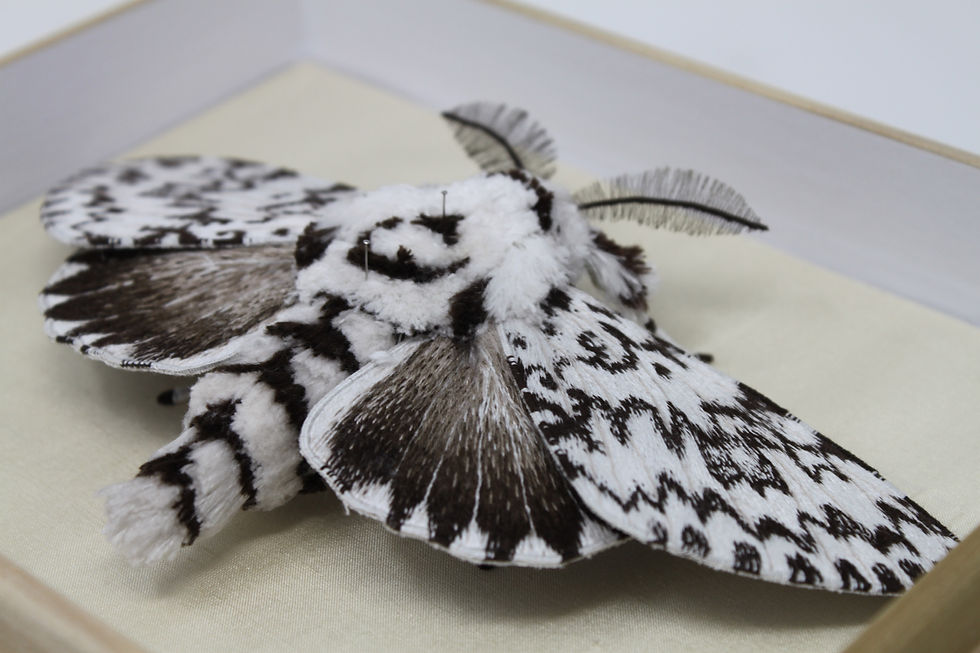Dressing the Torah
- Tzipporah Johnston

- Sep 23, 2020
- 4 min read
It’s a halachic requirement to keep the Torah scroll respectfully covered when not in use, but each Jewish ethnic group has its own traditional ways of doing so. Most (but not all) Edot HaMizrach communities – i.e. Jews from Arab lands – store Torah scrolls in hard wooden cases, so they are outside the remit of this textile project. However Ashkenazi, Sephardi (Spanish and Portuguese), and Italian communities, as well as a small number of Edot HaMizrach communities, all create soft textile covers for their scrolls.

Italian and Sephardi (S&P) mantles share a lot of similarities: they tend to be long, completely obscuring the lower handles of the wooden rollers holding the scroll (referred to in Hebrew as the etzei chaim, trees of life); they both generally consist of a wide skirt gathered and attached to a round or oblong top; they are most commonly front-opening, meaning that any inscriptions or motifs can only be placed on the back or sides of the mantle; and due to this and the effect of the full skirt, both types tend to be made of larger pieces of fabric with an all-over pattern, rather than featuring a central motif.


By contrast, Moroccan and Ashkenazi mantles are shorter and have a closer fit: Moroccan ones generally have a slightly trapezoid cloak attached to a soft top, while Ashkenazi ones are usually straight-sided and conform quite closely to the shape of the scroll, so decorative elements are clearly visible and undistorted by pleats. Like the Sephardi and Italian covers, Moroccan mantles are often front-opening, with a plain linen ‘undershirt’ to avoid the scroll being accidentally exposed. Ashkenazi mantles – the type you are most likely to encounter in a U.K. synagogue, and arguably across the world – deal differently with the prohibition on leaving a Torah scroll uncovered. They are almost exclusively back-opening, offering greater protection for the scroll, but also leaving the front of the mantle free for large-scale decorative motives or inscriptions.


These covers are very distinctive and clearly identify their communities of origin, partly because they are so closely aligned with local fashions and tailoring techniques. Even their names suggest the connection between mantles and clothing. Meil/ מעיל (Hebrew), mantello (Italian), and mantl/ מאַנטל (Yiddish), all literally translate to ‘coat’, while the Spanish name, vestido, means ‘dress’. This presents several options for the design of my mantle: it could take inspiration from any of the existing traditional cloth mantles, or it could take a new shape echoing modern dress fashions.

I haven’t yet settled on a final design, but there are a few issues that I’m bearing in mind. The scroll will, ideally, be used on an actual scroll, by an actual congregation. While a museum piece could be as avant-garde as I want, a ‘working’ mantle needs to fulfil the needs of its congregation. Their expectations, halachic norms, and aesthetic sense need to be considered. In the UK, it is likely that it will be going to an Ashkenazi community, so it may be more appropriate to use that style or something similar.
A functional mantle must also work within established Jewish visual language, while still feeling fresh and contemporary. A modern feel is usually achieved by careful choice of materials and a contemporary colour palette, but with donated fabric, both of these factors are out of my control, and the way the fabric itself is placed and manipulated thus becomes particularly important. From this perspective a closer-fitting mantle with space for a central motif might be more suitable than one with a fuller silhouette. The stars of the show are the fabric pieces that the covid-19 sewers have sent me. I want to do justice to them with a design that treats them as the precious objects they are. With a fuller style, the silhouette itself has impact, but any design made with the scraps is likely to be somewhat lost in the folds. A simpler silhouette offers a better canvas for a single large-scale design.
I have been experimenting with various ways of piecing scraps together to make larger fabric pieces that might be suitable for an Italian or Sephardi mantle, however, none have been entirely satisfactory. Somewhat counterintuitively, the more of the scrap fabrics I used, the more they got ‘lost’, and the ‘solid’ pieced samples I made had a folksy, rustic appearance that feels inappropriate for Torah vestments. Samples where small pieces of the scrub/mask fabric were carefully set into a plain fabric actually made them sing and honoured them better than simply using more of them.
(two samples, made using pieces of of navy fabric. The first is pieced, while the second uses fabric collage)
All of this makes it likely that I will end up making a mantle that more or less fits into the traditional Ashkenazi type. I’m continuing to make samples to try out ideas and get a sense of what works, but I think it’s helpful at this stage to have a sense of where to concentrate my sketching efforts. As I create more samples and start to make some decisions, I’ll continue to post them here.
Next post’s topic: Torah binders! You can’t have a soft Torah mantle without a binder to hold the scroll together, and there’s a rich history of Jewish women making and donating these. I’ll explain a bit about their history, and how that’s impacting my design choices.







Comments